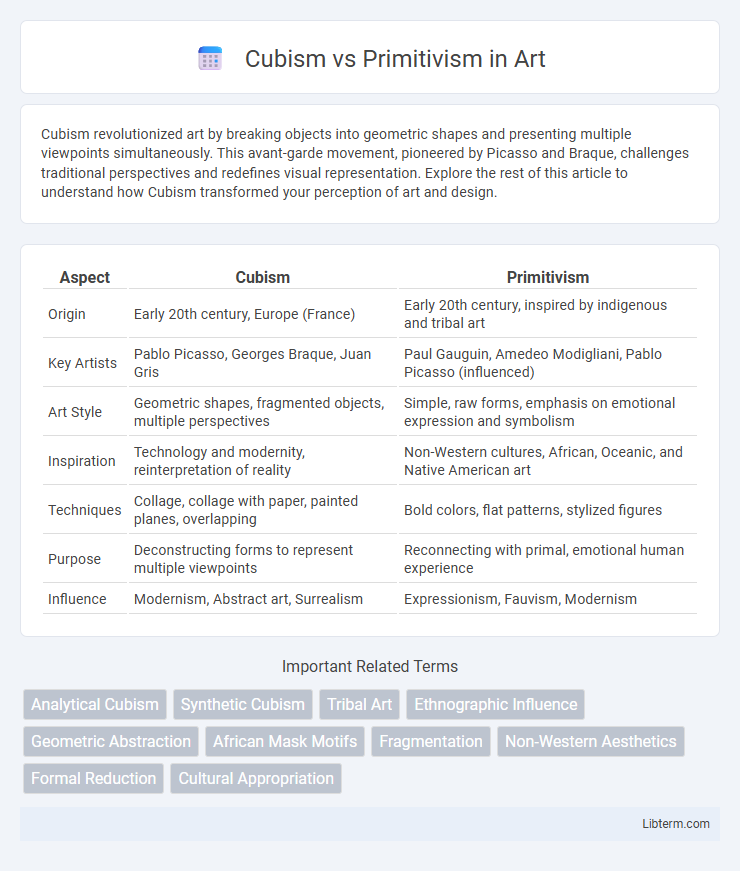Cubism revolutionized art by breaking objects into geometric shapes and presenting multiple viewpoints simultaneously. This avant-garde movement, pioneered by Picasso and Braque, challenges traditional perspectives and redefines visual representation. Explore the rest of this article to understand how Cubism transformed your perception of art and design.
Table of Comparison
| Aspect | Cubism | Primitivism |
|---|---|---|
| Origin | Early 20th century, Europe (France) | Early 20th century, inspired by indigenous and tribal art |
| Key Artists | Pablo Picasso, Georges Braque, Juan Gris | Paul Gauguin, Amedeo Modigliani, Pablo Picasso (influenced) |
| Art Style | Geometric shapes, fragmented objects, multiple perspectives | Simple, raw forms, emphasis on emotional expression and symbolism |
| Inspiration | Technology and modernity, reinterpretation of reality | Non-Western cultures, African, Oceanic, and Native American art |
| Techniques | Collage, collage with paper, painted planes, overlapping | Bold colors, flat patterns, stylized figures |
| Purpose | Deconstructing forms to represent multiple viewpoints | Reconnecting with primal, emotional human experience |
| Influence | Modernism, Abstract art, Surrealism | Expressionism, Fauvism, Modernism |
Introduction to Cubism and Primitivism
Cubism, pioneered by Pablo Picasso and Georges Braque in the early 20th century, revolutionized art by fragmenting objects into geometric shapes and presenting multiple perspectives simultaneously. Primitivism, influenced by non-Western and tribal art, emphasized raw, simplified forms and was embraced by modern artists seeking to break away from traditional European aesthetics. Both movements challenged conventional representation, with Cubism focusing on abstract deconstruction and Primitivism on the revival of ancient, tribal visual motifs.
Historical Context and Origins
Cubism emerged in the early 20th century, pioneered by Pablo Picasso and Georges Braque, as a radical departure from traditional European art by breaking objects into geometric shapes and multiple perspectives. Primitivism, influenced by non-Western art forms from Africa, Oceania, and indigenous cultures, sought to challenge Western conventions by embracing raw, simplistic, and symbolic aesthetics. The historical context of early modernism, marked by increased exposure to global art through colonialism and ethnographic exhibitions, deeply shaped both movements' origins and artistic philosophies.
Key Artists and Pioneers
Pablo Picasso and Georges Braque are central figures in Cubism, revolutionizing art with fragmented forms and multiple perspectives. Primitivism draws heavily from non-Western art, with artists like Paul Gauguin and Henri Matisse incorporating African and Oceanic motifs to challenge European conventions. Both movements share a focus on breaking traditional representation, yet Cubism emphasizes geometric abstraction while Primitivism seeks inspiration from indigenous cultures and raw, expressive forms.
Core Philosophies and Influences
Cubism centers on deconstructing objects into geometric shapes to represent multiple viewpoints simultaneously, emphasizing abstraction and the breakdown of traditional perspectives. Primitivism draws inspiration from non-Western and indigenous art forms, seeking to capture raw, elemental expressions and a return to perceived fundamental human creativity. Both movements significantly influenced modern art, with Cubism reshaping visual representation and Primitivism challenging Western aesthetic hierarchies.
Visual Characteristics and Techniques
Cubism employs fragmented, geometric shapes and multiple perspectives to depict subjects, emphasizing abstract forms and muted color palettes, often using collage and papier colle techniques. Primitivism draws inspiration from non-Western art, characterized by simplified, bold shapes, vibrant colors, and symbolic motifs, reflecting a raw, unrefined aesthetic. Both movements challenge traditional representation but differ in Cubism's analytical deconstruction versus Primitivism's emphasis on expressive, elemental forms.
Contrasting Approaches to Representation
Cubism fractures objects into geometric shapes to depict multiple viewpoints simultaneously, emphasizing abstraction and deconstruction of form. Primitivism draws inspiration from non-Western art, prioritizing simplified, symbolic representation to convey raw, emotional essence over realistic detail. These contrasting approaches reflect Cubism's analytical focus versus Primitivism's evocative, culturally rooted expression.
Cultural Appropriation and Ethical Debates
Cubism, pioneered by Pablo Picasso and Georges Braque, drew heavily from African and Indigenous art forms, raising complex issues of cultural appropriation as Western artists often borrowed without adequate acknowledgment of the original cultural contexts. This blending sparked ethical debates regarding power dynamics, where marginalized cultures' artifacts were decontextualized and commodified within European avant-garde movements. Contemporary discourse demands a critical examination of these interactions to promote respect for cultural heritage and foster equitable artistic exchange.
Impact on Modern Art Movements
Cubism revolutionized modern art by breaking objects into geometric shapes and presenting multiple perspectives simultaneously, influencing abstract art and movements like Futurism and Constructivism. Primitivism, inspired by non-Western and tribal art, challenged traditional Western aesthetics and encouraged artists to explore raw emotional expression and simplicity, impacting Expressionism and Surrealism. Together, these movements reshaped modern art by promoting innovation in form, perspective, and cultural themes.
Legacy in Contemporary Art
Cubism's legacy in contemporary art is evident through its radical abstraction and fragmented perspectives, influencing movements such as Abstract Expressionism and modern graphic design. Primitivism, despite its controversial appropriation of non-Western art forms, introduced a vital emphasis on raw, expressive aesthetics that continue to inspire contemporary artists exploring identity and cultural critique. Together, these movements reshaped artistic conventions, fostering innovation and expanding the boundaries of visual expression in the 20th and 21st centuries.
Conclusion: Comparing Lasting Significance
Cubism revolutionized visual perception by deconstructing form and enabling multiple perspectives, profoundly influencing modern art and design principles. Primitivism, though impactful in challenging Western aesthetics through its appropriation of indigenous art, sparked ongoing debates about cultural respect and authenticity. The lasting significance of Cubism lies in its foundational role for abstract art movements, whereas Primitivism's legacy is more complex, highlighting dialogues on cultural exchange and artistic innovation.
Cubism Infographic

 libterm.com
libterm.com